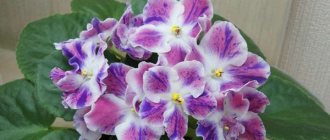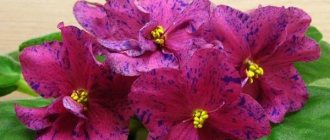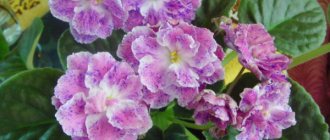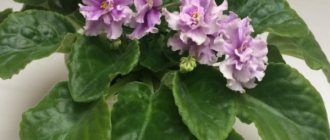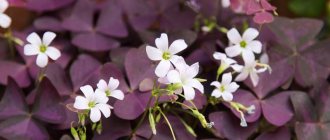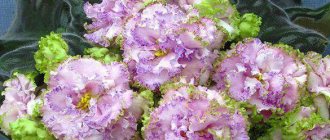From the fantastic variety of violet varieties obtained by domestic breeders, flower growers should pay especially close attention to the expressive decorative violets RM Charlotte and RM Winter Morning (N. Skornyakova).
These varieties of violets
differ:
- Elegant flower design;
- Fantasy notes in the color of the corollas;
- And also ease of care and maintenance.
Information about the breeder
Charming violets with large corollas of exquisite colors and shades were formed in the process of breeding development of Saintpaulia varieties by Kursk violet grower Natalya Skornyakova and have the common abbreviation “RM” in their name.
For about two decades now, since the first decade of the new century, an experienced master has been cultivating and breeding his own varietal violets.
The selection line of her Saintpaulias is dedicated to her mother, Raisa Mikhailovna , whose name appears in the branded prefix. All varieties are different:
- Extraordinary decorative configuration of the rims;
- And quite stable repeatability of varietal characteristics.
ATTENTION! Specimens of violets of these two varieties described are among the participants in countless exhibitions, take prizes, deserve favorable reviews from specialist violet growers and enjoy the trust of many domestic flower growers.
Botanical description of the plant
Violet is a plant up to 35 cm high with a compact rosette of bright green, moderately dense leaves. The leaves of the Malachite Rose have pronounced waviness, veining and a slight edge. The leaf blades are rounded and elongated on short light emerald petioles.
The flowers are large, reaching 5 cm in diameter. Having blossomed, the double violet takes the shape of a five-pointed star. They have a light pink color with an ashy tint. A distinctive feature is a lush, wide greenish border, which emphasizes the tenderness of the flower. During the peak flowering period, peduncles on flexible stems bend towards the leaves under the weight of the inflorescence, which numbers up to 5 copies.
Systematics of varieties
Based on the official hierarchical rules for systematizing taxa of botanical units, both violets are attributed to :
- To the universally large-scale in terms of the completeness of the varietal diversity that creates it;
- And to the Saintpaulia family, which is part of the Gesneriev family, seductive in the fantastic artistry of their embodied silhouettes.
Varietal specimens of recommended violets:
- According to the average values of the parameters of their overall bush characteristics, they are in the group of the standard section;
- And according to the characteristics of the size typology of the corollas, they belong to the large-flowered subspecies.
Diseases and pests
blight
"Bronze Horseman" is often infected with fungal diseases. Among the most common are late blight, gray and brown rot, and root rot.
The development of diseases occurs due to non-compliance with the rules of agricultural technology (overmoistening, too cold water, low temperature, and high humidity).
The following drugs are used for treatment: Maxi. Aktara. Prova-do. Aktofit. Fitoverm.
Pests: aphids; mites; thrips; nematodes. When they appear, remove all affected parts. Sticky tapes work well against these insects.
Violet RM-Charlotte
The variety appeared in the field of view of gardeners in 2016. We will see a photo and description of the RM-Charlotte variety below.
The Charlotte violet appeared in 2016.
Description of decorative features
The varietal violet in the adult state is distinguished by sufficient spatial and volumetric symmetry with a good density of filling with leaves - its rosettes, under the right conditions of maintenance, are formed by bushes of a compact configuration. According to the average figures of the overall dimensions of its volumetric mass, the violet represents a section of the standard subspecies.
At the beginning of the phase of completing the silhouette of the bush, the violet behaves absolutely independently, distributing only slightly pecked young leaves according to the number of floors - tiers - planned by the varietal characteristics, sufficient to ensure the decorative attractiveness of the rosette.
Saintpaulia extremely carefully places all the leaf plates in their places . Thanks to this, the bush, as in architectural practice, forms a magnificent pattern of mosaic alternation of leaves.
After the process of rosette formation is completed, each section of it can:
- To be illuminated by the rays of a star to a relatively equal extent;
- And receive the optimal charge of solar energy.
The leaves of the medium-sized variety have :
- Wide oval shape with soft and uniform curves along the entire length of the contour;
- Surface with quilted texture;
- Completely filled with a mass of the finest fibers;
- Remarkably pressed venation pattern, distinguished by the light green shade of the graphics;
- And not only the central, but also the lateral veins are significantly thick.
The leaf blades are painted in the green tone of lush summer foliage . Along the edges of the leaves there are very small, rounded and clearly cut teeth.
INTERESTING! The leaf plates themselves have a completely uneven format - their lateral contours in a varied sequence bend down towards the flowerpot, creating a slightly larger volume of the violet bush. This feature of the leaves does not harm the decorative attractiveness of the variety.
Violet leaves are the color of summer green.
Flowering in violets occurs extremely luxuriantly and over long periods of time , at the very first budding reaching almost the greatest fullness of disclosure of the varietal volume and brightness of the color of the corollas.
The variety begins flowering with single buds or small caps, which gradually gain in size as the violet matures :
- Maximum strength;
- And pomp.
The typology of flower format classifies them as a “star” subspecies.
Violet corollas are different:
- Terry degree of filling with petals;
- And quite large in size.
The side contours of each petal are decorated with:
- Wave-like curves;
- And a finely textured fringe, which is also responsible for the function of an even greater voluminous increase in flowers.
The main varietal feature of violets is the spectacular coloring of its corollas . It consists of:
- Playing shades of pink of different color intensities;
- And a finely speckled fantasy spray of fuchsia tones, sprinkled over the entire surface of the petals.
The edges of the petals are decorated in the form of a snow-white braid , which, due to the fringed structure of the edge, resembles exquisite lace.
NOTABLE! The width of the white ribbon varies at all levels of the corolla: thickened on the lower petals, it becomes thinner as it moves towards the center and may be completely absent on the innermost petals.
Saintpaulia grows large flowers.
Sports
retains its varietal characteristics quite , but occasionally blooms with a sport that is distinguished by the degeneration of the speckled fantasy coating into intense spots and strokes of darker, almost burgundy shades.
IMPORTANT! The leaf blades of sports specimens also change color and are characterized by a dark color.
The violet in question sometimes has sports.
Course of life stages
Varietal violet is characterized by relatively easy behavior in terms of response to measures of agricultural care and maintenance - it is absolutely satisfied with the use of classical regimes and methods.
Specificity of development in indoor collections
The Saintpaulia variety is different:
- Unpretentiousness;
- Developing at a rapid pace;
- The flowering period reaches within the time limits determined by standard characteristics.
Varietal violets can bloom for a long time, delighting flower growers:
- The pomp of the hats;
- Unusual colors;
- And preserving the decorative effect of flowers until they age completely.
Some other positive touches of the violet image include:
- Independence in the process of bush formation;
- Enchanting splendor of fantasy decorative flowers;
- Attempts to form flower caps from the first wave of budding;
- Large texture of the corollas.
The variety has practically no obvious disadvantages . Minor nuances include some waviness of the leaves, which does not disturb the overall impression of the decorative violet.
ATTENTION! One can also note the fading of the color splendor in the hot microclimate of the collections, but this shortcoming is easily corrected by adjusting the care regimes.
Features of reproduction
Only vegetative propagation is available:
- Leaf babies;
- Or stepchildren.
Feedback on warmth in flowers
When keeping a plant in a home microclimate, heat can cause the color to fade - the intensity of the fantasy color scheme on the petals and the volume of the fantasy pattern increases, and the white edge can almost completely disappear.
In order to preserve all the varietal characteristics of the violet, it is best to move it to somewhat cool conditions .
CAREFULLY! Flowers and buds of the variety fall off when exposed to sudden heat changes and drafts!
Pedicel strength
Violet forms dense and strong peduncles of optimal length , capable of constantly supporting heavy corollas in a straight position.
Flowering type
The varietal violet immediately tries to bloom in a cap type, but it achieves the varietal characteristics of the volume and splendor of the caps gradually, with an increase in the number of flowering waves.
Flower lifespan
Violet corollas remain viable for up to a month .
The presented variety blooms for about a month.
Reviews
Antonina Mikhailovna. “ The blooming of the RM-Charlotte violet gives me purely aesthetic pleasure - its rather large corollas are similar to the exquisite flowers of Chinese roses, but differ from them in the beautiful shades of pink carnations. And the motley fantasy of specks all over the petals and marvelous white lace along the contour of the flowers are the final chord of this splendor. In addition to the decorative nature of the violet, it is not capricious.”
Garden viola for growing in a summer cottage
Senopolya is an unpretentious guest of even a novice gardener's site. Such violets can be grown both in sunny meadows and in dark places. With insufficient light, the plant takes root well, but does not bloom as profusely or brightly. Growing senopoly in the shade, gardeners noticed that the flowers received a more faded color, but a much longer flowering period. Light, slightly acidic soil with a moderate amount of moisture is suitable for growing garden violets. Despite the fact that the plant is moisture-loving, stagnation of water in the area can be detrimental to this flower, so the plant is not planted on uneven surfaces. Many people value garden viola not only for its ease of care and unpretentiousness, but also for its frost resistance.
Violet RM-Winter Morning
The beautiful violet RM-Winter Morning, a photo of which you can see below, has been appearing at exhibitions since 2022.
Violet RM-Winter Morning appeared in 2022.
Description of decorative touches
Varietal violet is different :
- No difficulties in terms of bookmarking;
- And the formation of adult leaf rosettes.
The bushes grow without outside help , completely independently organizing their volumetric structure within symmetrical boundaries and absolutely in accordance with the characteristics of the variety.
This feature of the development of varietal Saintpaulia is valued quite highly by violet growers, as it allows them to save time and effort without thinking about the process of forming the violet silhouette.
The growth of a young violet bush in optimal conditions consists of carefully arranging the growing leaves on several “floors” of the rosette, following the example of the architectural technique of sequentially varying components in the mosaic technique.
In this case, each individual leaf of the plant has access to the necessary amount of energy from the luminary for its comfortable life development.
INTERESTING! In terms of the size of its overall structure, the violet is in the section of the standard subspecies, but the rosettes of most Saintpaulia varieties do not grow even to the average values of the standard size, forming medium-sized bushes with an even configuration of spatial contours.
Small-sized leaves have:
- Almost perfect heart shape;
- Very lumpy surface with a shiny texture;
- Symmetrical venation graphics, distinguished by a salad shade of color;
- And chiseled contours ending in coarsely carved, pointed teeth.
The color scheme of the leaves is consistent with the lush green tones of summer foliage.
The leaf blades may have a small hollow at the base of the leaf , which is why they look like small shuttles, and also form a wavy edge, lifting the side edges up or twisting them down towards the flowerpot.
Saintpaulia blooms very luxuriantly and abundantly.
The violet blooms extremely luxuriantly , maintaining the fresh attractiveness of the corollas for a long time. The flowers are different:
- Significant diameters;
- Semi-double filling structure;
- Delicate petal texture;
- And a “star” shape.
The wavy edges of each of the petals, furthermore decorated with an elegant fringe, are responsible for increasing the spatial scale of the corollas .
The special value of the violet is the color of its flowers : the white petals closer to the core of the flower have:
- Small bright pink prints with smooth transitions of shade intensity;
- And lilac fantasy strokes and dashes, which in the general plan of the corolla looks like a charming eye.
This variety has an unusual color.
NOTABLE! Along the edge of the central petals there can be a thin edging, painted with flowers of a pink and lilac palette.
Sports
Violet quite consistently repeats all its varietal characteristics, but at the same time it is distinguished by the frequent occurrence of sports specimens . Sports have lilac-violet shades in the central part of the corollas; fantasy is almost completely absent from them.
The violet in question has sport.
Detailed analysis of life phases
The variety in indoor collections does not create significant problems , being characterized by its easy response to agrotechnical care measures.
Specific nuances of indoor maintenance
Appearing in collections relatively recently, violet has managed to become a favorite of many flower growers , since in addition to the exquisite decorative nature of flowers, it has a lot of undeniable advantages.
With careful care, the rosette of the variety forms itself , without any problems, and will have very harmonious and even dimensions.
IMPORTANT! Violet has no special disadvantages, other than frequent sportsability.
The uniqueness of the stages of reproduction
It is possible to use propagation only by vegetative means :
- Leaf babies;
- Layerings of an adult specimen.
Flower response to heat
In extreme heat, flowers may experience an increase in the volume of pink prints .
Pedicel structure
For violets, peduncles of a strong structure .
Type of flowering form
The violet gradually begins to bloom in caps of lush volumes .
The presented violet has a cap bloom.
Time of vital freshness of a flower
The corollas retain their healthy shape for more than a month.
Reviews
Zoya Ilyinichna. “ The violet “RM-Winter Morning” settled in my collection from the very first moment of its presentation at the exhibition; its delicate beauty won my heart. There were no problems with development at home, but when trying to get new bushes, the children blossomed into cute sports.”
Reviews
Daria Mikhailovna. “The violet “SM-Legend of St. Petersburg” already grows in my collection; I received it from a friend who was cleaning her shelves and getting rid of seedlings. My violet grows beautifully, doesn’t require much attention, and blooms in gorgeous caps. The flowers of my seedling, to my taste, are much more beautiful than many varietal violets. I have never regretted that I took it into the collection - such beauty cannot be superfluous!”
The variety in question has many positive reviews.
Care techniques in indoor culture
Both violets are distinguished by their unpretentious characters - their bushes develop well and bloom gracefully in voluminous waves in response to the careful and regular implementation of simple agricultural practices:
- Plants should be placed on a window facing west or east; specimens from windows to the north should be provided with additional rays with a diffuse spectrum, to the south - unobtrusive artificial protection is required;
- to water violets in small doses from the moment when the top drying of the substrate is visually clearly visible;
- It is best to apply additional fertilizing with mineral fertilizers
- Provide light to varieties primarily from daylight, long-lasting, with a spectrum of scattered rays;
- Control a constant heat level within +20 + 24°C ; eliminate sudden fluctuations in the temperature gradient;
- Plant rosettes in nutritious, permeable soil with good aeration; ensure the creation of a sufficiently reliable drainage layer;
- At the time of transplantation , use a gentle transfer more often, unless there are special indications.
Origin story
The violet variety “Bronze Horseman” was bred in 2011 by breeder from Ukraine Elena Lebetskaya.
The breeder was faced with the task of obtaining unusual flowers that would match the shade of the leaves. The homeland of all violets is the East African province. In honor of the governor of this province, another name for violets is “Saintpaulia”.
Information about other violets bred by E. Lebetskaya, their descriptions and photos can be found in a separate article.
Distinctive features
The main feature is a common love for violets, which were bred by Evgeny Arkhipov. His Saintpaulias became regular guests at American exhibitions. Flowers truly have a masculine character. These varieties are not whimsical compared to others.
The violets grown by Evgeniy have:
- Original and unique colors.
- Three or four color palette.
- Unique appearance.
It is these features that make Eugene’s violets recognizable after the first flower blooms.
If you want to learn about other violet breeders and get acquainted with the unusual varieties they have produced, read our articles about Natalya Puminova, Konstantin Morev, Elena Korshunova, Alexey Tarasov, Boris and Tatyana Makuni, Elena Lebetskaya, Svetlana Repkina, Natalia Skornyakova, Tatyana Pugacheva and Tatyana Dadoyan.
